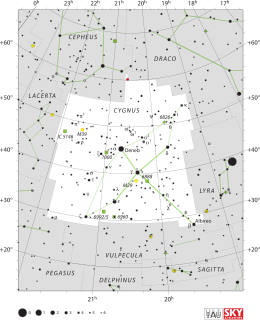HD 187123
Da Wikipedia, l'enciclopedia libera.
| HD 187123 | |
|---|---|
| Classe spettrale | G5V |
| Distanza dal Sole | 150,1 ± 0,2 anni luce (46,021 ± 0,061 pc) |
| Coordinate | |
| (all'epoca J2000.0) | |
| Ascensione retta | 19h 46m 58.1123s[1] |
| Declinazione | +34° 25′ 10.2799″[1] |
| Dati fisici | |
| Raggio medio | 1,143[2] R⊙ |
| Massa | |
| Temperatura superficiale | |
| Metallicità | 132% rispetto al Sole |
| Dati osservativi | |
| Magnitudine app. | +7,89 |
| Magnitudine ass. | 4,41 |
| Parallasse | 21,7316±0,0336 mas[1] |
| Moto proprio | AR: 142,581±0,053 mas/anno Dec: −123,603±0,063 mas/anno[1] |
| Nomenclature alternative | |
HD 187123 è una stella di sequenza principale di tipo G di ottava magnitudine situata a circa 150 anni luce di distanza nella costellazione del Cigno. Come il nostro Sole, è una nana gialla (tipo spettrale G5V). Non è visibile ad occhio nudo, ma dovrebbe essere un obiettivo facile con un binocolo o un piccolo telescopio.

Sistema planetario
[modifica | modifica wikitesto]Nel 1998 il team di California e Carnegie Planet Search, dopo aver seguito un suggerimento di Kevin Apps, che all'epoca era uno studente universitario[3] trovò un possibile pianeta in orbita attorno alla stella[4]. C'erano anche indicazioni di un altro corpo più distante in orbita e questa affermazione è stata pubblicata nel 2006[5]. Questo secondo pianeta è stato confermato nel 2009[6].
Prospetto del sistema[7][2]
[modifica | modifica wikitesto]| Pianeta | Tipo | Massa | Periodo orb. | Sem. maggiore | Eccentricità | Scoperta |
|---|---|---|---|---|---|---|
| b | Gioviano caldo | >0,5074 MJ | 3,0965886 giorni | 0,04213 au | 0,0076 | 1998 |
| c | Giove eccentrico | >1818±0,25 MJ | 3324±46 giorni | 4,417 au | 0,28 | 2006 |
Note
[modifica | modifica wikitesto]- ^ a b c d (EN) A. G.A. Brown, A. Vallenari e T. Prusti, Gaia Data Release 2 - Summary of the contents and survey properties, in Astronomy & Astrophysics, vol. 616, 1º agosto 2018, pp. A1, DOI:10.1051/0004-6361/201833051. URL consultato il 28 dicembre 2019.
- ^ a b c d Y. Katherina Feng, Jason T. Wright, Benjamin Nelson, Sharon X. Wang, Eric B. Ford, Geoffrey W. Marcy, Howard Isaacson e Andrew W. Howard, The California Planet Survey IV: A Planet Orbiting the Giant Star HD 145934 and Updates to Seven Systems with Long-period Planets, in The Astrophysical Journal, vol. 800, n. 1, 2015, Bibcode:2015ApJ...800...22F, DOI:10.1088/0004-637X/800/1/22, arXiv:1501.00633.
- ^ British student shows Nasa new planet, su news.bbc.co.uk.. "BBC News". 25 settembre 1998. URL consultato il December 31, 2011.
- ^ Butler, R. Paul; et al. (1998). "A Planet with a 3.1 Day Period around a Solar Twin". Publications of the Astronomical Society of the Pacific. 110 (754): 1389–1393. Bibcode: 1998PASP..110.1389B, su ui.adsabs.harvard.edu.. CiteSeerX 10.1.1.37.5463. doi: 10.1086/316287.
- ^ Wright, J.T.; et al. (2007). "Four New Exoplanets and Hints of Additional Substellar Companions to Exoplanet Host Stars". The Astrophysical Journal. 657 (1): 533–545. arXiv:astro-ph/0611658. Bibcode: 2007ApJ...657..533W, su ui.adsabs.harvard.edu.. doi: 10.1086/510553.
- ^ Wright, J.T.; et al. (2009). "Ten New and Updated Multi-planet Systems, and a Survey of Exoplanetary Systems". The Astrophysical Journal. 693 (2): 1084–1099. arXiv:0812.1582. Bibcode: 2009ApJ...693.1084W, su ui.adsabs.harvard.edu.. doi: 10.1088/0004-637X/693/2/1084.
- ^ Cam Buzard et al., Simulating the Multi-Epoch Direct Detection Technique to Isolate the Thermal Emission of the Non-Transiting Hot Jupiter HD187123B (PDF), 2020.
Voci correlate
[modifica | modifica wikitesto]Altri progetti
[modifica | modifica wikitesto] Wikimedia Commons contiene immagini o altri file su HD 187123
Wikimedia Commons contiene immagini o altri file su HD 187123
Collegamenti esterni
[modifica | modifica wikitesto]- Notes for star HD 187123, su The Extrasolar Planets Encyclopaedia. URL consultato il 25 agosto 2008.
Text is available under the CC BY-SA 4.0 license; additional terms may apply.
Images, videos and audio are available under their respective licenses.

